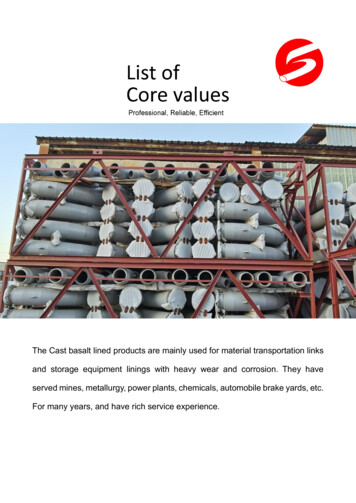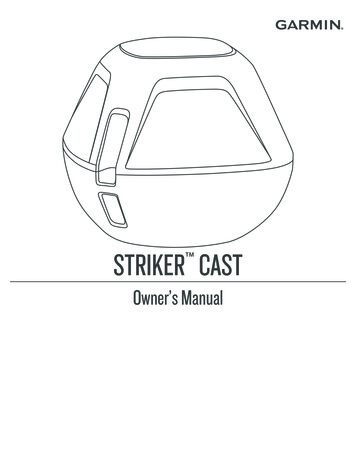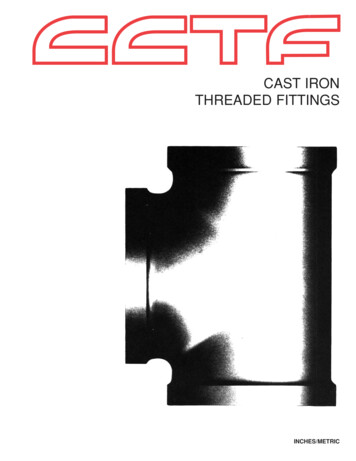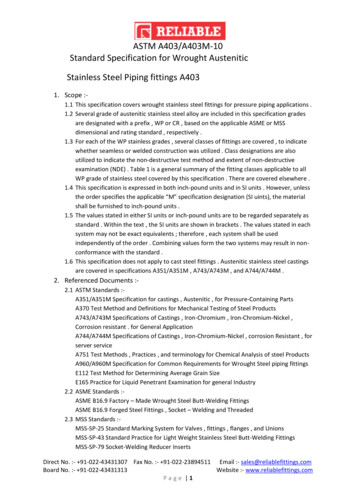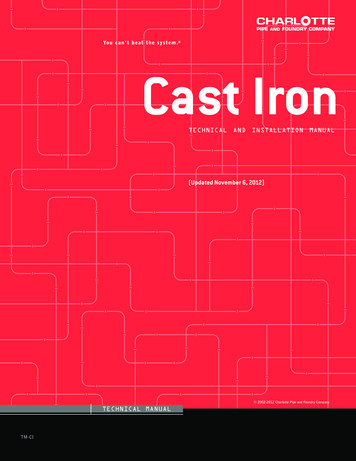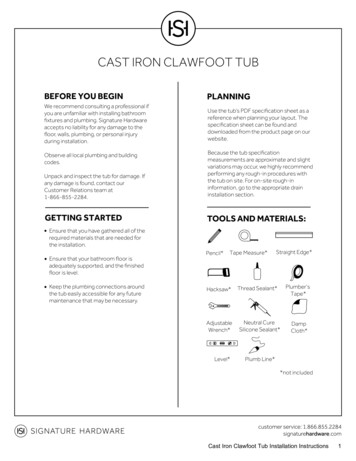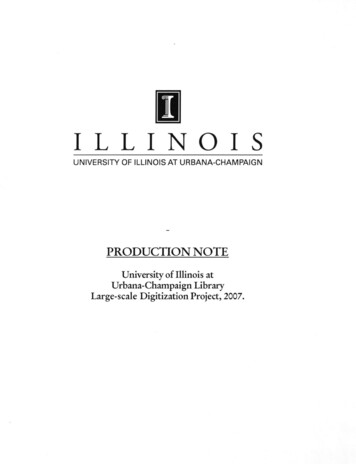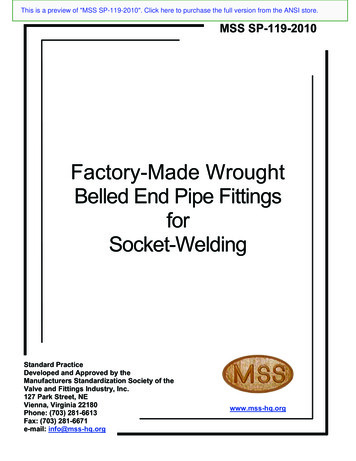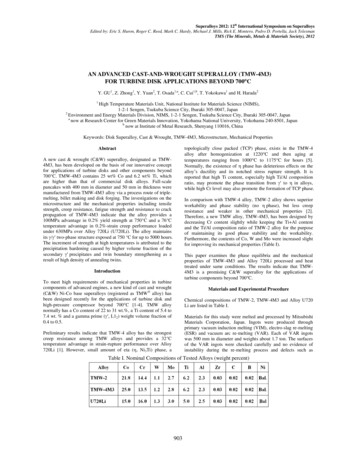
Transcription
Superalloys 2012: 12th International Symposium on SuperalloysEdited by: Eric S. Huron, Roger C. Reed, Mark C. Hardy, Michael J. Mills, Rick E. Montero, Pedro D. Portella, Jack TelesmanTMS (The Minerals, Metals & Materials Society), 2012AN ADVANCED CAST-AND-WROUGHT SUPERALLOY (TMW-4M3)FOR TURBINE DISK APPLICATIONS BEYOND 700 CY. GU1, Z. Zhong1, Y. Yuan2, T. Osada1,a, C. Cui1,b, T. Yokokawa1 and H. Harada21High Temperature Materials Unit, National Institute for Materials Science (NIMS),1-2-1 Sengen, Tsukuba Science City, Ibaraki 305-0047, Japan2Environment and Energy Materials Division, NIMS, 1-2-1 Sengen, Tsukuba Science City, Ibaraki 305-0047, Japananow at Research Center for Green Materials Innovation, Yokohama National University, Yokohama 240-8501, Japanbnow at Institute of Metal Research, Shenyang 110016, ChinaKeywords: Disk Superalloy, Cast & Wrought, TMW-4M3, Microstructure, Mechanical Propertiestopologically close packed (TCP) phase, exists in the TMW-4alloy after homogenization at 1220 C and then aging attemperatures ranging from 1000 C to 1175 C for hours [5].Normally, the existence of phase has deleterious effects on thealloy’s ductility and its notched stress rupture strength. It isreported that high Ti content, especially high Ti/Al compositionratio, may promote the phase transition from to in alloys,while high Cr level may also promote the formation of TCP phase.AbstractA new cast & wrought (C&W) superalloy, designated as TMW4M3, has been developed on the basis of our innovative conceptfor applications of turbine disks and other components beyond700 C. TMW-4M3 contains 25 wt% Co and 6.2 wt% Ti, whichare higher than that of commercial disk alloys. Full-scalepancakes with 400 mm in diameter and 50 mm in thickness weremanufactured from TMW-4M3 alloy via a process route of triplemelting, billet making and disk forging. The investigations on themicrostructure and the mechanical properties including tensilestrength, creep resistance, fatigue strength and resistance to crackpropagation of TMW-4M3 indicate that the alloy provides a100MPa advantage in 0.2% yield strength at 750 C and a 76 Ctemperature advantage in 0.2%-strain creep performance loadedunder 630MPa over Alloy 720Li (U720Li). The alloy maintainsits two-phase structure exposed at 750 C for up to 5000 hours.The increment of strength at high temperatures is attributed to theprecipitation hardening caused by higher volume fraction of thesecondary precipitates and twin boundary strengthening as aresult of high density of annealing twins.In comparison with TMW-4 alloy, TMW-2 alloy shows superiorworkability and phase stability (no phase), but less creepresistance and weaker in other mechanical properties [2].Therefore, a new TMW alloy, TMW-4M3, has been designed bydecreasing Cr content slightly while keeping the Ti Al contentand the Ti/Al composition ratio of TMW-2 alloy for the purposeof maintaining its good phase stability and the workability.Furthermore, the contents of Co, W and Mo were increased slightfor improving its mechanical properties (Table I).This paper examines the phase equilibria and the mechanicalproperties of TMW-4M3 and Alloy 720Li processed and heattreated under same conditions. The results indicate that TMW4M3 is a promising C&W superalloy for the applications ofturbine components beyond 700 C.IntroductionTo meet high requirements of mechanical properties in turbinecomponents of advanced engines, a new kind of cast and wrought(C&W) Ni-Co base superalloys (registered as TMW alloy) hasbeen designed recently for the applications of turbine disk andhigh-pressure compressor beyond 700 C [1-4]. TMW alloynormally has a Co content of 22 to 31 wt.%, a Ti content of 5.4 to7.4 wt. % and a gamma prime ( L12) weight volume fraction of0.4 to 0.5.Materials and Experimental ProcedureChemical compositions of TMW-2, TMW-4M3 and Alloy U720Li are listed in Table I.Materials for this study were melted and processed by MitsubishiMaterials Corporation, Japan. Ingots were produced throughprimary vacuum induction melting (VIM), electro-slag re-melting(ESR) and vacuum arc re-melting (VAR). Each of VAR ingotswas 500 mm in diameter and weights about 1.7 ton. The surfacesof the VAR ingots were checked carefully and no evidence ofinstability during the re-melting process and defects such asPreliminary results indicate that TMW-4 alloy has the strongestcreep resistance among TMW alloys and provides a 32 Ctemperature advantage in strain-rupture performance over Alloy720Li [1]. However, small amount of eta ( , Ni3Ti) phase, aTable I. Nominal Compositions of Tested Alloys (weight percent)903
cracks, pores or heavy segregations were observed. Chemicalanalysis showed that most of the elemental compositions werewell controlled to the nominal values, although Al and Ti contentsslightly varied within the VAR ingots, which might be caused bythe ESR process. The VAR ingots homogenized below the γ’solvus temperature were forged successfully and the final billetsof 200 mm diameter were obtained without surface cracks. Themicrostructure was fine and homogeneous enough for furtherprocessing. Several pancake disks of tested alloys were forged atthe same deformation condition under 1100 C, which are 400 mmdiameter and 50 mm thickness as shown in Figure 1.The phase constitution and the microstructure evolution caused byheat treatment and thermal exposure were observed by opticalmicroscopy, X-ray diffraction, scanning electron microscopy(SEM) and transmission electron microscopy (TEM). Thespecimens were prepared by metallographic polishing followed byetching in a solution of Marble reagent (10 g CuSO4 50 ml HCl 50 ml H2O). TEM samples were electrochemically polishedwith a twin jet polisher using a solution of 83% ethanol, 7%glycerol and 10% perchloric acid at -25 C.Mechanical testings were performed according to ASTM E8/E21,ASTM E139, ASTM E606 and ASTM E647 standard testmethods for tensile, creep, low-cycle fatigue (LCF) and fatiguecrack growth rate (FCGR), respectively,Results and DiscussionMicrostructure and Microstructural StabilityThe equilibrium phases of the TMW-4M3 at 760 C wereanalyzed by using the Thermo-Calc program (Version N) and NiRUMN database (Thermo-Calc Software, Sweden) as shown inFigure 2. Several key thermodynamic data are listed in Table III.Figure 1. Pancake forged from TMW-4M3 alloyAll specimens were cut from the pancakes. The samples of Alloy720Li were treated with its standard heat-treatment conditionwhile the samples of TMW-4M3 were treated under twoconditions as indicated in Table II.Table II. Heat Treatment Schedules of the Tested AlloysFigure 2. Calculated phase fraction vs temperature diagram ofTMW-4M3.Table III. Key Thermodynamic Data of TMW-4M3 Alloy904
TMW-4M3 was predicted to contain , , (from 1083 C to1218 C), sigma ( ) (existed from 570 C to 752 C), and someminor phases such as carbide and boride.However, no and phases were found in the sample treated at1200 C/1h and then cooled to 760 C with a cooling rate of0.5 C/h (Figure 3), which passed the phase forming region inthe Thermo-Calc result and TMW-4 alloy [5]. Furthermore, and phases did not existed in the samples treated at 1200 C/1h/WQand then exposed at 850 C, 750 C and 650 C for 5000 hours,which indicates that TMW-4M3 alloy has better microstructuralthermal stability than that of TMW-4 alloy.Figure 3. TTT curve of the phase forming region in TMW4 [5] and cooling line in TMW-4M3.Figure 4. Typical microstructures after heat treatment: (a) Alloy720Li; (b)TMW-4M3-2.4M3 alloy. The total twin length in an area of 150 150 m was2.45, 5.03 and 5.15 mm in Alloy U720Li, TMW-4M3-1 andTMW-4M3-2, respectively (Figure 4b). High twin formabilitymay be caused by low stacking fault energy (SFE) in TMW-4M3alloy [6].Microstructural features of each heat treated alloys are shown inFigure 4. The grain size and other characters are listed in Table IV.It is noted that the grain size for TMW-4M3-2 treated at1120 C/4h is 10.6 m, which is almost the same as that of Alloy720Li treated at its standard heat-treatment condition. Meanwhile,high density annealing twins were found in the heat treated TMW-Table IV. Microstructural Characteristics of Tested Alloys905
Table V. Tensile Properties of Tested AlloysTensile Strength and Creep Propertiestwo conditions had almost the same strength level and were about100 MPa higher than that of Alloy 720Li.The tensile tests were conducted at room temperature (20 C),650 C and 750 C, respectively. 0.2% yield strength (YS),ultimate tensile strength (UTS), elongation (EL) and reduction ofarea (RA) are given in Table V. Below 650 C, all tested alloyshad comparable tensile YS while the YS strength of TMW-4M3decreased by about 2% with the increase of the solutiontemperature. At 750 C, YS and UTS of TMW-4M3 treated underStress-rupture tests were conducted in air under loads rangingfrom 480MPa to 840 MPa in temperatures ranging from 650 C to760 C. TMW-4M3 alloy treated under two conditions exhibited agreat improvement in the creep resistance compared with AlloyU720Li at all tested temperatures and stresses (Table VI). Bycomparison of the life to 0.2% strain at the stress level of 630MPa,Table VI. Tensile Creep Properties of Tested Alloys906
Figure 5. Larson-Miller stress-life plot for (a) life to 0.2% creep strain; (b) rupture life of TMW-4M3 alloy in comparison with reported U720Li [6],718Plus[7] and ME3[8].a temperature gain of about 76 C can be expected from TMW4M3-2 alloy by using of Larson-Miller parameter approachcommonly employed for disk alloys (Figure 5a). Meanwhile, forthe same 0.2% creep strain life (Figure 5a), the loading stress ofTMW-4M3 was nearly twice as much as that of Alloy U720Li.The Larson-Miller comparison of rupture life for TMW-4M3alloys along with those of U720Li [7], 718 PLUS [8] and ME3alloy [9] (also known as Rene 104, with grain size of about 30 m) shows that TMW-4M3 can be comparable with ME3 alloy athigher stress level (Figure 5b).Representative TEM micrographs of the tensile tested samples areshown in Figures 6. The significant observation here is that thenano-scale coherent twin boundaries (TBs) as a result of highFigure 6. TEM micrographs showing the deformation substructures after tensile tested at 725 C in(a) TMW-4M3, (b) TMW-4M3, (c) Alloy 720Li, (d) TMW-4M3.907
density annealing twins supply additional barriers to themovement of dislocation, and the dislocations could not penetratedirectly through TBs during deformation (Figures 6a and 6b). InAlloy 720Li, shearing of γ’ precipitates by super-dislocation pairswas the dominant deformation model up to 725 C (Figure 6C). InTMW-4M3 alloy, the deformation model was the same as that inAlloy 720Li at 25 C. However, at 725 C, γ’ precipitates weremainly cut by stacking faults and deformation twins (Figure 6d).Low Cycle Fatigue (LCF) and Fatigue Crack Growth (FCG)PropertiesLCF tests were conducted under strain control condition using atriangular waveform with a frequency of 0.5 Hz over a wide rangeof total strain amplitude of 0.8% to 1.2% and strain ratio R min/ max 0 on smooth cylindrical specimens at 650 C and 725 C.Normally, the peak stresses as a function of cumulative strain didnot essentially change during cycling and the stress amplitudedropped rapidly at the end period of the test in TMW-4M3 alloy(Figure 7a), which indicates that most of the fatigue life was usedto initiate crack.Generally speaking, superalloys develop high temperaturestrength through solid solution strengthening, precipitatehardening and grain boundary strengthening. Compared withAlloy 720Li, TMW-4M3-2 alloy has similar grain size and lowercontents of solid solution strengthening elements such as W andMo. Therefore, the improvement in the strength of TMW-4M3may mainly contribute from its higher γ’ volume fraction and itslarge number of annealing twin boundaries (TBs). Because thedistribution and the size of the tertiary precipitates in all testedalloys were not significantly affected by the heat treatmentconditions (Table IV), the increase of the fractions of secondary precipitates and TBs was very likely responsible for the strengthimprovement at high temperatures, which implies a novel strategyfor enhancing high-temperature strength in disk superalloys [10].It is obvious that the TMW-4M3 exhibits higher fatigue life atlower strain amplitudes at both 650 C and 725 C (Figures 7b and7c). The benefit difference in fatigue life, however, narrows downat higher strain amplitudes and is comparable at 650 C and 725 Cunder t 1.2%.FCG tests were carried out in air at 650 C and 725 C for stressratios of R and 0.5 (R min/ max) by using compacttension specimens (CT) (12.7 mm in thickness, 61 mm in width).All specimens were pre-cracked at room temperature at aFigure 7. Dependence of fatigue life (Nf) on strain range (Δεt) of TMW-4M3 and Alloy 720Li908
frequency of 20Hz. A closed-loop servo-hydraulic testingmachine with specimens cycled under stress-intensity (K) control(a symmetric, triangular waveform with a frequency of 2Hz andvarious load ratios). During the tests, crack-length measurementswere determined from the unloading elastic compliance measuredby a capacitance gage mounted across the notch mouth. Stressintensities were determined from the linear-elastic solutions forthe CT geometry given in ASTM Standard E-399.Figure 8 shows schematically the crack growth rate da/dN as afunction of the stress intensity factor range K at 650 C and 725 C for R 0.05 and 0.5 in a log-log scale. Assuming the Paris lawFigure 8. Cyclic fatigue crack growth rates tested at 650 C and 725 C for a stress ratios R and 0.5.Table VII. C and m Values Determined from da/dN versus ΔK Plots for the Tested Alloys.909
is applicable to the tested alloys, the slope (m value) and constantC values for Paris regime, where FCGR behavior is representedby da/dN C( K)m , were compared for Alloy 720Li and TMW4M3 at various testing conditions in Table VII. At a given testcondition, the m and C values for Alloy 720Li and TMW-4M3alloy were comparable. The FCGRs of both Alloy 720Li andTMW-4M3 alloys were similar except the result at 725 C for R 0.5, where Alloy U720Li had lower FCGR when K was belowabout 50 MPa m (Figure 8d). This may be caused by the lower Crcontent of TMW-4M3, which may decrease its oxidationresistance at high temperatures and long exposure time duringtested at high R value.Creep Behavior of Nickel Base Superalloy U720Li,” Acta Metall.Sinca, 37(11) (2001), 1159-1164.8. W. D. Cao and R. Kennedy, “Role of Chemistry in 718-typeAlloys-Allvac 718PlusTM Alloy Development,” Superalloys 2004,ed. K. A. Green et. al. (Warrendale, PA, USA: TMS, 2004), 91-99.9. Timothy P. Gabb et al., “Characterization of the TemperatureCapabilities of Advanced Disl Alloy ME3,” (Report NASA TM2002-211796, August 2002).10. Y. Yuan et al., “A Novel Strategy for the Design of AdvancedEngineering Alloys — Strengthening Turbine Disk Superalloysvia Twinning Structures,” Adv. Eng. Mater., 13 (2011), 296-300.Summary & ConclusionsThe paper evaluates the thermal phase stability and mechanicalproperties of two C&W disk superalloys, TMW-4M3 and AlloyU720Li. It is shown that TMW-4M3 alloy has about 100MPahigher yield strength compared with Alloy U720Li at 750 C andcan provide at least 40 C temperature advantage in creep-ruptureperformance over Alloy U720Li loaded under 630MPa. Theresistances to LCF and FCGR are better at 650 C for TMW-4M3and are comparable at 725 C. Meanwhile, a higher solutiontemperature over Alloy 720Li is beneficial for TMW-4M3 alloyto get superior mechanical properties, which implies that furtherenhancement of properties in this alloy is possible. These resultsindicate that TMW-4M3 is a promising C&W disk material forturbine applications beyond 700 C.AcknowledgementsPartial financial support by the New Energy and IndustrialTechnology Development Organization (NEDO) of Japan isgratefully acknowledged. The authors are grateful the supply ofmaterials for this research from Mitsubishi Materials Corporationand the support of mechanical property testing from KobeMaterials Testing Laboratory Co., Ltd.References1. Y. F. Gu et al., “New Ni-Co-base Disk Superalloys with HigherStrength and Creep Resistance,” Scripta Materialia, 55 (2006),815-818.2. Y. F. Gu et al., “Development of Ni-Co-base Alloys for HighTemperature Disk Application,” Superalloys 2008, ed. Roger C.Reed et al. (Warrendale, PA, USA: TMS, 2008), 53-61.3. Y. F. Gu et al., “Comparison of Mechanical Properties of TMWAlloys, New Generation of Cast-and-wrought Superalloys forDisk Application,” Metall. Mater. Trans. A, 40 (2009), 3047-3050.4. H. Harada et al., “Heat-resistance Superalloy,” EuropeanPatent, EP 1842934, October 19, 2011.5. C. Y. Cui et al., “Microstructural Evolution and MechanicalProperties of a Ni-base Superalloy, TMW-4,” Metall. Mater.Trans. A, 40 (2009), 282-291.6. Y. Yuan et al., “Influence of Co Content on Stacking FaultEnergy in Ni–Co Base Disk Superalloys,” J. Mater. Res., 26(2011), 2833.7. Xiao X, Zhou LZ and Guo JT, “Microstructural Stability and910
properties of TMW-4M3 and Alloy 720Li processed and heat treated under same conditions. The results indicate that TMW-4M3 is a promising C&W superalloy for the applications of turbine components beyond 700 C. Materials and Experimental Procedure Chemical compositions of TMW-2, TMW-4M3 and Alloy U720 Li are listed in Table I.
